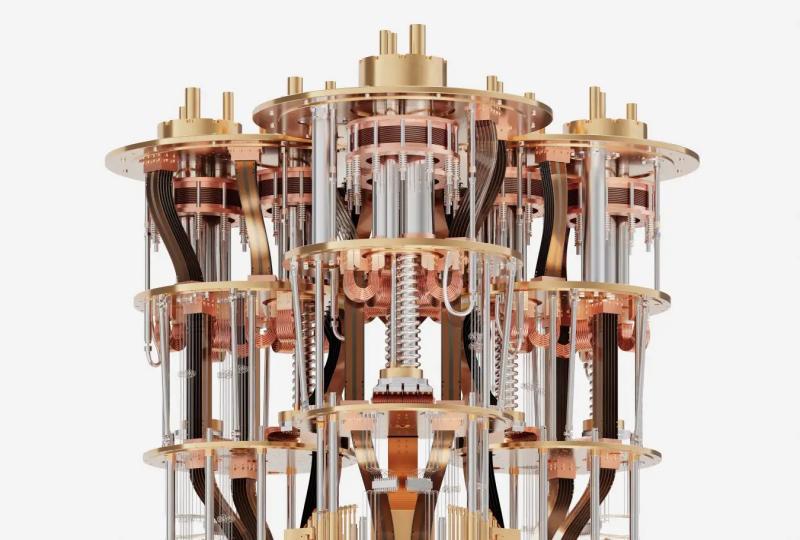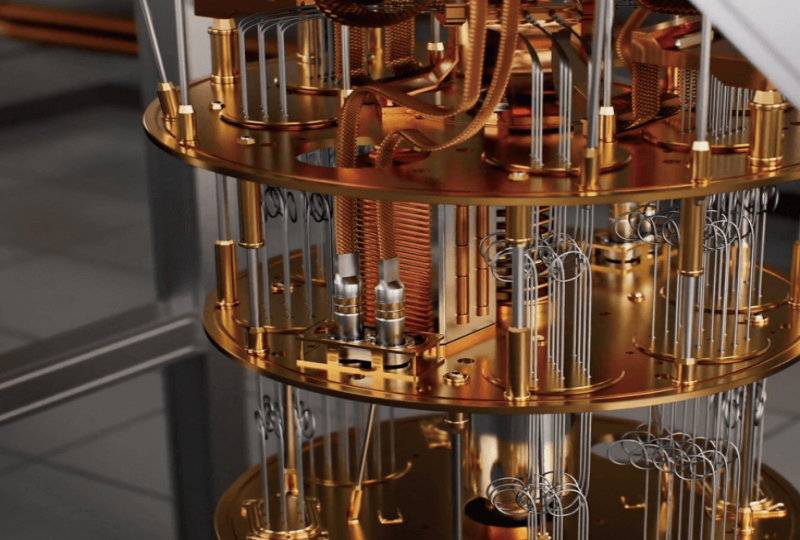9 Types of Qubits Driving Quantum Computing Forward [2025]
2025.03.28 · Blog
Qubits are the fundamental units of quantum information, and different physical systems are being developed to create and manipulate qubits.
In this article, we will explore 9 different types of qubits, each with its unique set of features, advantages, and challenges in quantum computing.

#1 Superconducting Qubits
Superconducting qubits are among the most developed and widely studied qubit technologies and are used by major quantum computing companies.
Superconducting qubits are based on superconducting circuits, which are electrical circuits that carry current with zero resistance at extremely low temperatures. These qubits are created using Josephson junctions, which are devices that allow for the controlled flow of supercurrent. The quantum state of the qubit is encoded in the energy levels of the circuit.
Major Players in Superconducting Quantum Computing
1. IBM Q: IBM's superconducting quantum processors use transmon qubits.
2. Google Willow: On December 9th 2024, Google announced its latest quantum chip: a 105-qubit superconducting Willow chip.
3. SpinQ: SpinQ uses its superconducting QPU in its SpinQ Superconducting Quantum Computer aimed at commercial applications.
Advantages of Superconducting Qubits
Highly developed and mature technology: So far, superconducting qubits have been the most developed and widely studied types of qubits.
High Scalability: Superconducting qubits have demonstrated the ability to scale up. IBM Condor reached 1,121 qubits, demonstrating continued scalability efforts.
Fast Gate Operations: They offer high gate speeds, which are essential for running complex quantum algorithms efficiently.
High-Fidelity Operations: Superconducting qubits can achieve high quantum fidelity (i.e., accuracy) in quantum gate operations, reducing computational errors and enhancing quantum computations' reliability.
Integration with existing semiconductor technology: Superconducting qubits are also compatible with semiconductor fabrication processes, allowing for the possibility of mass production and large-scale integration.
Strong Coupling Between Qubits: Superconducting qubits can be easily coupled to one another, enabling efficient entanglement creation and interaction between qubits, which is crucial for many quantum algorithms and protocols.
Disadvantages of Superconducting Qubits
Cryogenic Requirements: Superconducting qubits require cooling to near absolute zero (around 10-20 millikelvins) using dilution refrigerators to maintain superconductivity, which increases operational costs and complexity.
Decoherence and Noise Sensitivity: Superconducting qubits are highly sensitive to environmental noise, such as electromagnetic radiation, which can cause decoherence (loss of quantum information). The qubits' coherence times (the time over which they retain quantum information) are still relatively short.
Error Correction Complexity: While superconducting qubits have achieved high-fidelity gates, quantum error correction remains a challenge. Implementing fault-tolerant quantum computing requires sophisticated error correction protocols, which demand more qubits and overhead, complicating the overall quantum system.
#2 Trapped Ion Qubits
Trapped ion qubits are based on individual ions (charged atoms) that are trapped in electromagnetic fields. Quantum information is stored in the internal states of the ions, which can be manipulated using laser pulses.
Trapped ion systems are known for their high precision and the ability to perform operations with very low error rates. The ions can be entangled using controlled laser interactions, a crucial element for quantum computation.
Major Players in Trapped-Ion Quantum Computing
1. IonQ: IonQ is a leading company in trapped ion quantum computing. In 2023, IonQ demonstrated a trapped-ion quantum computer called Forte with 36 qubits. It showcases all-to-all connectivity and high-fidelity operations.
2. Honeywell Quantum Solutions: Honeywell uses trapped ion technology in their quantum computers, focusing on building scalable and highly accurate systems. Its System Model H1 has been available commercially since September 2020, which features 10 high-fidelity qubits that are fully connected, allowing for more complex quantum circuits.
3. Quantinuum: The System Model H2 (56 Qubits) is Quantinuum's latest quantum computer, designed with a racetrack architecture. It achieved a record quantum volume of 2,097,152.
Advantages of Trapped Ion Qubits:
High Fidelity: Trapped ion qubits offer very high quantum state fidelity, making them ideal for implementing quantum algorithms.
Long Coherence Times: The qubits in a trapped ion system can remain in their quantum states for a long time, which is essential for running quantum algorithms that require multiple steps.
High-Quality Entanglement: Ion qubits can be entangled with high precision, enabling the execution of complex quantum operations.
Disadvantages of Trapped Ion Qubits:
Scalability Challenges: As each ion needs to be individually controlled with lasers, scaling up trapped ion systems to thousands of qubits is challenging.
Slow Gate Operations: Trapped ions typically have slower gate operation times compared to superconducting qubits, limiting the speed of computations.
#3 Photonic Qubits
Photonic qubits use photons, the fundamental particles of light, to carry quantum information. In this setup, quantum information is encoded in properties of the photon, such as polarization, phase, or path.
Photons are manipulated using optical components like beam splitters, phase shifters, and waveplates. Photonic qubits are well-suited for quantum communication and cryptography, as photons can travel over long distances with minimal loss.
Top Companies Advancing Photonic Qubit Technology
1. Xanadu: Xanadu focuses on building quantum computers that use photonic qubits, leveraging continuous-variable quantum computing.
2. PsiQuantum: PsiQuantum is working on building large-scale photonic quantum computers using silicon photonics technology.
Advantages of Photonic Qubits:
1. Room Temperature Operation: Photonic qubits can operate at room temperature, unlike other qubit types that require cryogenic environments.
2. Ideal for Quantum Communication: Photons are the ideal candidates for quantum communication networks due to their ability to travel long distances without losing coherence.
3. Scalability: Photonic qubits can be generated and manipulated on chips, potentially enabling scalable quantum computing architectures.
Disadvantages of Photonic Qubits:
Difficult to Manipulate: Manipulating and entangling photons requires precise control over optical components, which can be challenging.
Loss in Transmission: Photons can experience losses as they travel through optical fibers or other media, reducing the effectiveness of the quantum operations over long distances.
#4 Topological qubits
Topological qubits encode quantum information in the braiding of topologically protected quasiparticles known as anyons.
These qubits are based on the principles of topological quantum computing, where the quantum state is stable against local perturbations due to the non-local nature of the encoded information. The braiding process makes topological qubits more resistant to errors caused by environmental noise.
Microsoft: Major Player in Topological Quantum Computing
Microsoft's StationQ project is exploring topological qubits as part of their vision for scalable, fault-tolerant quantum computers.
In February 2025, Microsoft unveiled Majorana 1, the world's first quantum processor powered by topological qubits. This breakthrough chip leverages a new class of materials called topoconductors, allowing precise control of Majorana particles to create more stable and reliable qubits. The Majorana 1 chip marks a critical milestone in Microsoft's mission to develop a scalable, fault-tolerant quantum computer.
Advantages of Topological Qubits:
Error Resistance: Topological qubits are theoretically less susceptible to noise and decoherence, which makes them potentially ideal for large-scale, fault-tolerant quantum computing.
Intrinsic Fault Tolerance: The topological nature of the qubit ensures that computational errors can be corrected more easily without requiring extensive error correction schemes.
Disadvantages of Topological Qubits
Experimental Challenges: Topological qubits remain largely theoretical, and no large-scale topological quantum computer has yet been realized.
Complexity: Creating and manipulating topologically protected states requires advanced materials and experimental setups, which are still in the research phase.
#5 Neutral Atom Qubits
Neutral atom qubits are based on individual neutral atoms trapped in a lattice of laser light. The quantum information is encoded in the internal states of the atoms, and lasers are used to manipulate these states.
Neutral atoms are ideal for creating large-scale quantum systems because they interact weakly with the environment, which helps preserve quantum coherence.
Key Players Advancing Neutral Atom Quantum Computing
1. QuEra: QuEra Computing specializes in neutral-atom quantum computing, utilizing Rydberg atom technology to construct scalable quantum systems. Their architecture is designed to enhance qubit interactions, offering reconfigurable connectivity and extended coherence times, while striving to minimize cross-talk.
2. Infleqtion: Infleqtion focuses on atom-based quantum technologies that advance sensing systems and quantum computing applications. It achieved a significant breakthrough by creating a 16×16 neutral atom array, totaling 256 atoms—the largest of its kind in the UK.
3. Atom Computing: In October 2023, Atom Computing achieved a significant milestone by developing a quantum computing platform with a 1,225-site atomic array populated with 1,180 qubits.
4. Harvard University: Researchers at Harvard are exploring neutral atom systems for large-scale quantum computing architectures.
5. Aliro Quantum: Aliro Quantum does not manufacture neutral atom quantum computers, but they are developing quantum networking solutions that leverage neutral atom technology for secure communication, distributed quantum computing, and networked quantum sensing.
Advantages of Neutral Atom Qubits:
Long Coherence Times: Neutral atoms have long coherence times, which is ideal for performing extended quantum computations.
Scalable: Laser trapping enables the scalable arrangement of neutral atoms in optical lattices, making it possible to create large quantum processors.
Disadvantages of Neutral Atom Qubits:
Difficult to Manipulate: Precise control of neutral atoms, especially when scaling to larger systems, remains a significant experimental challenge.
Slow Gate Operations: The manipulation of neutral atoms requires slower processes compared to other qubit types, limiting the speed of quantum computations.
#6 Spin Qubits
Spin qubits rely on the spin states of electrons or nuclei to encode quantum information. The two possible spin states, “up” and “down,” serve as the binary states of a qubit.
These qubits are typically realized in semiconductor materials, making them an attractive option for integration with existing semiconductor technologies, like those used in classical computing.
Key Players Advancing Spin-Based Quantum Computing
1. Intel Quantum Computing: Intel is developing spin qubits in silicon using 300-millimeter CMOS manufacturing techniques, aiming to use their expertise in semiconductor technology to create scalable quantum processors. In June 2023, Intel introduced "Tunnel Falls," a 12-qubit silicon quantum chip. Tunnel Falls is crucial for Intel's broader strategy of integrating quantum processors with control electronics on the same chip, simplifying the architecture of quantum systems and making them more scalable.
2. University of Sydney: Researchers at the University of Sydney are also investigating spin qubits using quantum dots in semiconductor materials.
Advantages of Spin Qubits:
Compatibility with Existing Semiconductor Technology: Spin qubits can potentially be fabricated using the same technologies used to manufacture classical silicon chips, which could enable large-scale quantum computers.
Long Coherence Times: Spin qubits are capable of maintaining quantum coherence for longer periods compared to some other qubit types.
Disadvantages of Spin Qubits:
Difficult to Isolate from Environmental Noise: Spin qubits are susceptible to decoherence caused by external magnetic fields and other environmental factors.
Scalability: While spin qubits have the potential for scalability, precise control of individual qubits is still a major challenge.
#7 Quantum Dot Qubits
Quantum dot qubits use quantum dots—nanoscale semiconductor structures that confine electrons in all three spatial dimensions—as the physical substrate for qubits.
The quantum state of the qubit is determined by the electron's charge or spin. Quantum dot qubits are advantageous because they can potentially be fabricated using existing semiconductor manufacturing techniques.
Major Players Advancing Quantum Dot Qubits
1. Intel: Intel's quantum research team is investigating quantum dots as a possible qubit platform, leveraging their expertise in semiconductor manufacturing.
2. University of Sydney: Researchers are using quantum dots to explore the potential for scalable quantum computing systems.
Advantages of Quantum Dot Qubits
Scalability: Quantum dots can be manufactured using established semiconductor fabrication processes, which could lead to scalable quantum computing.
Integration with Classical Electronics: Quantum dot qubits can be integrated with existing classical electronics, making it easier to combine quantum and classical systems in hybrid computing architectures.
Disadvantages of Quantum Dot Qubits
Control and Isolation: Quantum dots require highly precise control, and isolating the qubits from unwanted interactions is a significant challenge.
Limited Coherence Time: Quantum dot qubits have relatively short coherence times compared to other qubit types, limiting the number of quantum operations that can be performed.
#8 Diamond Nitrogen-Vacancy (NV) Center Qubits
NV center qubits are based on defects in diamond crystals, where a nitrogen atom replaces a carbon atom, creating a vacancy in the crystal lattice. These NV centers can be manipulated using microwave and optical fields to encode quantum information.
NV center qubits are unique because they can operate at room temperature, which sets them apart from other qubit types that require cryogenic environments.
Major Players Advancing Diamond NV Center Qubits
1. Element Six: Element Six is developing diamond-based quantum technologies, including NV center qubits for quantum sensing and computation.
2. University of California, Berkeley: Researchers are exploring the use of NV centers in diamonds for quantum computing applications.
Advantages of Diamond NV Center Qubits:
Room Temperature Operation: NV center qubits can operate at room temperature, unlike many other qubit types that require extremely low temperatures.
Quantum Sensing Applications: NV centers are ideal for applications in quantum sensing, particularly for detecting magnetic fields and other environmental factors with high precision.
Disadvantages of Diamond NV Center Qubits:
Scalability Issues: It is difficult to control and manipulate large numbers of NV centers in a single diamond, which makes scaling challenging.
Error Rates: NV center qubits have relatively high error rates compared to other qubit types, which limits their effectiveness for certain applications.
#9 Nuclear Magnetic Resonance (NMR) Qubits
NMR qubits use the nuclear spins of atoms (typically hydrogen or carbon) to encode quantum information. The quantum state is manipulated using magnetic fields and radiofrequency pulses.
NMR quantum computing has been a pioneering technology but is limited in terms of scalability and operational speed.
Major Players in Nuclear Magnetic Resonance (NMR) Quantum Computing
1. SpinQ: SpinQ is a prominent leader in Nuclear Magnetic Resonance (NMR) quantum computing. It successfully developed the world's first portable quantum computer, "SpinQ Gemini Mini." The Gemini and Triangulum series stand out for their affordability, maintenance-free operation, and high stability, providing comprehensive quantum computing solutions for quantum education and research.

2. University of California, Los Angeles (UCLA): UCLA researchers have also explored NMR systems for small-scale quantum computing experiments.
Advantages of NMR Qubits
Well-Established Methods: NMR techniques are well-established and have been used for many years in spectroscopy and imaging, offering precise control over qubits.
Small-Scale Systems: NMR qubits work well for small quantum computing systems with a limited number of qubits.
Disadvantages of NMR Qubits
Limited Scalability: NMR qubits are not suitable for scaling up to large quantum processors.
Slow Operational Speed: NMR quantum computers tend to have slow operational speeds, which limits their practical applications.
Conclusion
As quantum computing evolves, researchers are exploring a variety of qubit technologies, each with unique properties that could make them suitable for different types of quantum computers. While each qubit type has its strengths and weaknesses, the ultimate goal is to combine them in hybrid systems that leverage the best aspects of each technology.
Currently, superconducting qubits and trapped ion qubits are the two most mature technologies, already being used in commercial quantum computers. On the other hand, neutral atom qubits and spin qubits have significant potential in terms of scalability and are rapidly developing. Topological qubits are still in the research stage but may bring revolutionary breakthroughs in the future.
Featured Content
Popular Reads




.png)

